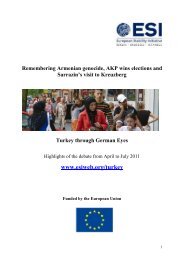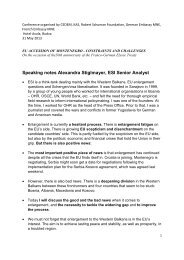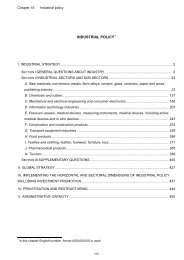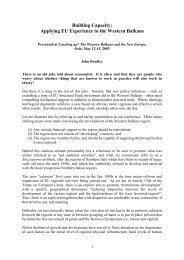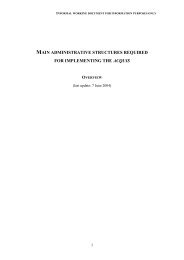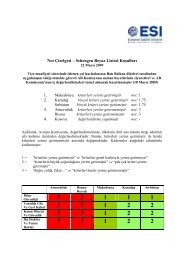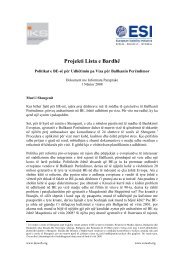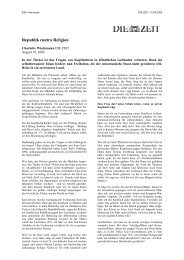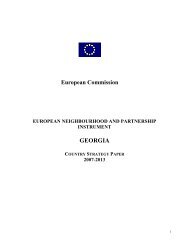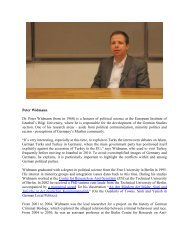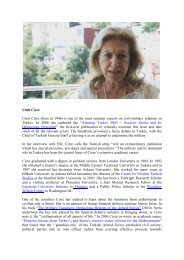Gender Assessment for USAID/Caucasus/Azerbaijan
Gender Assessment for USAID/Caucasus/Azerbaijan
Gender Assessment for USAID/Caucasus/Azerbaijan
Create successful ePaper yourself
Turn your PDF publications into a flip-book with our unique Google optimized e-Paper software.
II. Background<br />
The <strong>USAID</strong>/<strong>Caucasus</strong> Mission partners with Georgian and <strong>Azerbaijan</strong>i counterparts to<br />
develop a prosperous and peaceful region based on democratic principles, market<br />
economies, and civic participation at all levels. The <strong>USAID</strong>/<strong>Caucasus</strong>/<strong>Azerbaijan</strong><br />
program has been and continues to transition from humanitarian assistance to long-term<br />
development building on the foundations established by <strong>USAID</strong> regional programs since<br />
1992. The Mission does not have stand-alone activities specifically focused on gender<br />
issues, but integrates gender concerns across the strategic objectives. 1<br />
In FY 2004 <strong>USAID</strong>/<strong>Caucasus</strong>/<strong>Azerbaijan</strong> will develop the Mission’s new three-year<br />
strategy. As part of the preparations <strong>for</strong> the new strategy, the Mission sought to<br />
undertake a gender assessment <strong>for</strong> the <strong>USAID</strong>/<strong>Caucasus</strong>/<strong>Azerbaijan</strong> Mission.<br />
<strong>Assessment</strong>s have been done on the internally-displaced persons (IDP) and refugee<br />
populations and in some health areas that touch on gender. However, due to the lack of<br />
gender studies in <strong>Azerbaijan</strong> on the population as a whole, <strong>USAID</strong> has undertaken this<br />
gender assessment to gain a better understanding of gender issues across all sectors of<br />
<strong>Azerbaijan</strong>. The Mission will look to the assessment <strong>for</strong> guidance on identifying gender<br />
issues connected with current programming to deepen those activities and impacts, and<br />
<strong>for</strong> recommendations on monitoring and evaluation over the new three-year strategy<br />
period. The analysis and recommendations provided in the assessment will assist the<br />
Mission in mainstreaming gender into its new strategy, policies and procedures. 2<br />
The Automated Directive System (ADS) section 201.3.8.4 requires that a gender analysis<br />
be conducted as part of the strategy planning process. 3 To that end, this report will serve<br />
as a basis <strong>for</strong> understanding the overall situation <strong>for</strong> men and women in <strong>Azerbaijan</strong>, how<br />
<strong>Azerbaijan</strong>’s democratic, economic and social transition has affected both men and<br />
women, and how the role of gender is and can be influenced by<br />
<strong>USAID</strong>/<strong>Caucasus</strong>/<strong>Azerbaijan</strong> activities. 4<br />
In addition, 3-hour gender integration training sessions were conducted both <strong>for</strong><br />
<strong>USAID</strong>/<strong>Caucasus</strong>/<strong>Azerbaijan</strong> staff and <strong>for</strong> implementing partners in Baku. The training<br />
should help lay the groundwork <strong>for</strong> implementation of strategic and practical solutions to<br />
gender-based problems. In addition, the training puts both Mission staff and partners on<br />
notice of the obligation to be gender aware in implementing <strong>USAID</strong> programs.<br />
1<br />
<strong>Gender</strong> <strong>Assessment</strong> Scope of Work, October 2003.<br />
2<br />
Ibid.<br />
3<br />
“Strategic Plans must reflect attention to gender concerns. Unlike other technical analyses described in<br />
this section, gender is not a separate topic to be analyzed and reported on in isolation. Instead, <strong>USAID</strong>’s<br />
gender mainstreaming approach requires that appropriate gender analysis be applied to the range of<br />
technical issues that are considered in the development of a given Strategic Plan.” See also III Conceptual<br />
Framework.<br />
4<br />
Background in<strong>for</strong>mation is based on the limited sources listed in the bibliography and interviews with key<br />
in<strong>for</strong>mants. See Annexes A and B.<br />
DevTech Systems, Inc. 1 <strong>USAID</strong>/<strong>Caucasus</strong>/<strong>Azerbaijan</strong><br />
<strong>Gender</strong> <strong>Assessment</strong>




